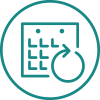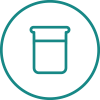

POCT Bilirubin


POCT Bilirubin
Purpose:
In adults, Total Bilirubin is typically measured for the investigation of jaundice as part of a panel of ‘liver function’ tests. Conjugated hyperbilirubinemia is indicative of hepatobiliary dysfunction and bilirubin is often used to monitor the course of the disease. An elevated serum unconjugated bilirubin is characteristic of haemolytic conditions or where there is ineffective erythropoiesis, however total bilirubin very rarely exceeds 100 μmol/L in such conditions.
In neonates the immature liver and an increase in haem turnover can cause a transient increase in unconjugated bilirubin, where the total bilirubin level can exceed 100 μmol/L, with concentrations in excess of 300 μmol/L carrying a risk of brain damage (kernicterus). The treatment threshold for phototherapy varies from > 100 μmol/L for age 0 to >350 at 96+hrs and > 100 μmol/L for age 0 to >450 at 42+hrs for transfusion therapy.
Guidance on the diagnosis and treatment of neonatal jaundice, including when to measure bilirubin is detailed in:
How to measure the bilirubin level
Use serum bilirubin measurement for babies:
- in the first 24hours of life or
- who have a gestational age of less than 35 weeks.
In babies who have a gestational age of 35weeks or more and who are over 24hours old, transcutaneous bilirubinometers can be used, however:
- if a transcutaneous bilirubinometer measurement indicates a bilirubin level greater than 250 μmol/L, measure the serum bilirubin to check the result
- use serum bilirubin measurement if bilirubin levels are at or above the relevant treatment thresholds for their age, and for all subsequent measurements.
The Bilirubin EQA programme is designed to assess laboratory and method performance in the laboratory investigation of jaundice for adults and neonates.
Scope:
Four liquid human serum samples are distributed monthly, with a minimum of 48 samples distributed over the year covering the clinically relevant range. The samples consist of a panel of 8 linearly related samples produced from donations from healthy volunteers spiked with conjugated and a mixed isomer source of unconjugated bilirubin. The four samples per distribution allows for the assessment of within laboratory imprecision whilst distribution of the same sample on a number of occasions over the year allows for the assessment of between batch imprecision. This programme is designed to assess laboratory and method performance, including linearity, bias, within and between batch imprecision.
Both neonatal and adult reference and pathological ranges are accommodated including challenging samples at clinical treatment thresholds. The samples are suitable for Point of Care testing, including bilirubinometers and Blood Gas analysers.
 |
Key Features:
|
| Bilirubin Programme | ||
|---|---|---|
| Analyte | Approx. Range Covered | |
| Total Bilirubin | 30 - 350 | µmol/L |
| Conjugated Bilirubin | 10 - 100 | µmol/L |
Related Documents








